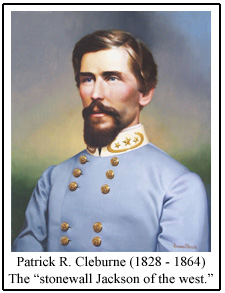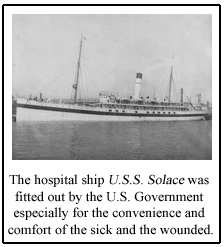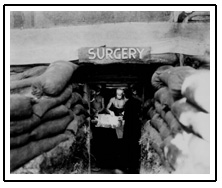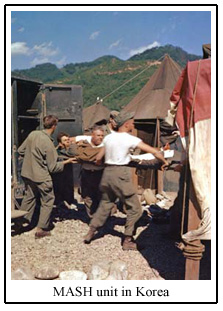Vol. 22 No. 4- April 2009

Volume 22, No. 3
Editor: Stephen L. Seftenberg
Website:
www.CivilWarRoundTablePalmBeach.org
NOTE CHANGE OF DAY AND DATE DUE TO PASSOVER
April Program
Colonel Jack Travis will present an in-depth study on the five flags
of the Confederacy. He will explain why men on both sides fought and
died for their flags. Come hear the Rebel Yell and see the Bonnie Blue
flag.
President's Message
If your dues are not paid by the end of the April
meeting, this will be the last newsletter that you will
receive and you will not be included in the 2009 directory. Your dues
pay for our meeting expenses and donations. There are openings for
speakers. If you would like to give a program, please let me know.
Remember to sign up for refreshments at the meeting. Cash donations are
also appreciate for the forage fund. It is with regret that I have
to say that Stuart Robinson passed away in February. We extend our
condolences to his family.
Gerridine La Rovere, President
Program: Wednesday, March 11, 2009
March biography:
 Member
Camille Granda introduced us to Patrick Romayne Cleburne.
Cleburne was born in Ireland. Orphaned at 15, he failed entrance exams
at Trinity Medical College; enlisted in the 43rd Regiment of the English
army where he rose to the rank of corporal. He purchased his discharge;
emigrated to Helena, Arkansas, where he became a pharmacist and a
lawyer, and became a US citizen in 1860. He went with the South solely
out of affection for his neighbors. He was elected captain of the Yell
Rifles; seized the US arsenal at Little Rock in 1861; his unit was added
to the 1st (later renamed the 15th) Arkansas Infantry Regiment; he was
elected Colonel and on March 4, 1862, Brig. General. His motto: Duty
Points the Way. Fought at Shiloh, Richmond, Kentucky (where he was
wounded in the face); promoted to command a Division in Arkansas; at
Stone River, his troops advanced 3 miles; promoted to Major General
12/13/62. Led a night assault at Chickamauga and fought rear guard
actions at Missionary Ridge and at Ringold Gap, Georgia that saved the
Confederate Army from disaster. His ability to utilize terrain to
advantage and to hold ground led to his nickname, "the Stonewall of the
West." Federal troops dreaded seeing his blue flag on the battlefield.
He felt that "slavery was not the sole reason for the war, only a
pretext for centralized government." His recommendation to draft and
emancipate blacks as soldiers in the army led to a fierce backlash in
the South. He soldiered on: outnumbered 4-to-l, he blocked Sherman at
Chattanooga and harassed Sherman’s advance through Georgia. Sent to
Kentucky, he was killed leading an ill-conceived attack he opposed at
Franklin, Kentucky on November 30, 1864, and was buried there (his
remains were later moved to Helena). Cleburne, a brilliant leader,
served under less competent generals and as a result got less attention
than he deserved. Sadly, he became engaged in 1864 but was killed before
he could marry. Member
Camille Granda introduced us to Patrick Romayne Cleburne.
Cleburne was born in Ireland. Orphaned at 15, he failed entrance exams
at Trinity Medical College; enlisted in the 43rd Regiment of the English
army where he rose to the rank of corporal. He purchased his discharge;
emigrated to Helena, Arkansas, where he became a pharmacist and a
lawyer, and became a US citizen in 1860. He went with the South solely
out of affection for his neighbors. He was elected captain of the Yell
Rifles; seized the US arsenal at Little Rock in 1861; his unit was added
to the 1st (later renamed the 15th) Arkansas Infantry Regiment; he was
elected Colonel and on March 4, 1862, Brig. General. His motto: Duty
Points the Way. Fought at Shiloh, Richmond, Kentucky (where he was
wounded in the face); promoted to command a Division in Arkansas; at
Stone River, his troops advanced 3 miles; promoted to Major General
12/13/62. Led a night assault at Chickamauga and fought rear guard
actions at Missionary Ridge and at Ringold Gap, Georgia that saved the
Confederate Army from disaster. His ability to utilize terrain to
advantage and to hold ground led to his nickname, "the Stonewall of the
West." Federal troops dreaded seeing his blue flag on the battlefield.
He felt that "slavery was not the sole reason for the war, only a
pretext for centralized government." His recommendation to draft and
emancipate blacks as soldiers in the army led to a fierce backlash in
the South. He soldiered on: outnumbered 4-to-l, he blocked Sherman at
Chattanooga and harassed Sherman’s advance through Georgia. Sent to
Kentucky, he was killed leading an ill-conceived attack he opposed at
Franklin, Kentucky on November 30, 1864, and was buried there (his
remains were later moved to Helena). Cleburne, a brilliant leader,
served under less competent generals and as a result got less attention
than he deserved. Sadly, he became engaged in 1864 but was killed before
he could marry.
March book review:
 Member
Ed Lewis discussed James McPherson’s new book, Trial By War: Abraham
Lincoln as Commander-in-Chief. McPherson, who won a Pulitzer Prize
for his Battle Cry For Freedom, focused on Lincoln’s growth as
military Commander-in-Chief. Few Presidents have acted as
Commander-in-Chief, leaving battlefield strategy and tactics to the
generals and admirals, and in the beginning Lincoln (whose only military
experience was two months in the Blackhawk War) followed the same
pattern. Once faced with war, however, he read many books. He stumbled
in the early months and made many "bad" appointments (out of the
mediocre group he could chose from until "stars" developed). While his
generals viewed the war as to conquer territory, Lincoln’s native genius
led him to see that the Confederate armies had to be utterly defeated if
the Union was to be preserved. He quickly saw the advantages the
telegraph and the railroad gave the Union forces and often slept at the
War Department telegraph office. As his confidence grew, his advice and
orders to his generals became more sophisticated. A similar earlier book
is T. H. Williams, Lincoln and His Generals (1952). Lincoln
finally found generals, such as Grant, Sherman, Sheridan, who were
aggressive and smart. Lewis recommended reading both these books. Member
Ed Lewis discussed James McPherson’s new book, Trial By War: Abraham
Lincoln as Commander-in-Chief. McPherson, who won a Pulitzer Prize
for his Battle Cry For Freedom, focused on Lincoln’s growth as
military Commander-in-Chief. Few Presidents have acted as
Commander-in-Chief, leaving battlefield strategy and tactics to the
generals and admirals, and in the beginning Lincoln (whose only military
experience was two months in the Blackhawk War) followed the same
pattern. Once faced with war, however, he read many books. He stumbled
in the early months and made many "bad" appointments (out of the
mediocre group he could chose from until "stars" developed). While his
generals viewed the war as to conquer territory, Lincoln’s native genius
led him to see that the Confederate armies had to be utterly defeated if
the Union was to be preserved. He quickly saw the advantages the
telegraph and the railroad gave the Union forces and often slept at the
War Department telegraph office. As his confidence grew, his advice and
orders to his generals became more sophisticated. A similar earlier book
is T. H. Williams, Lincoln and His Generals (1952). Lincoln
finally found generals, such as Grant, Sherman, Sheridan, who were
aggressive and smart. Lewis recommended reading both these books.
March program
Member Marsha Sonnenblick’s lavishly illustrated
lecture, US Medical Service Through Five Wars, used the device of taking
one young man and giving him a similar wound in each war. First is
Robert Forbes, in 1856, a 14-year old farm boy living in York,
Pennsylvania and an avid reader. At that time, Jefferson Davis, the US
Secretary of War, sent a committee (including McClellan) to study the
English medical service as well as English and Russian military tactics
in the Crimean War. The Civil War was fought in the last stages of
medieval medicine – American medical schools were a joke: it took no
qualification (except the ability to pay the fee) to attend or to
graduate. The US Army had about 100 surgeons, few of whom were
qualified. Drs. William Hammond and Jonathan Letterman served in the
West. During the war, over 11,000 surgeons were used by the North
(compared to about 3,000 by the South). Many doctors, many of whom had
never done an operation, rushed to join the army. The first part of Mrs.
Sonnenblick’s talk is limited to the Army of the Potomac in the early
stages of the war. Forbes joined the 39th Pennsylvania Regiment in June
1861.
A "minie" ball could go through several bodies and
become easily infected. Most wounds as a result led to amputation (by
the end of the war, 50,000 plus amputations were performed!). The
"surgeon" sharpened his implements on his shoe, wiped it off on his long
coat, and never washed his hands. 95% of surgeries used a light does of
chloroform, which the South had little of (in one incident, Phil
Sheridan provided Confederate doctors chloroform so they could operate
on Confederate soldiers captured by his troops). Mortality rates varied
by the location of the amputation: hands and fingers (26%), shoulder
(30%), upper arm (24%).
 Forbes
was wounded in the leg but laid out on the battlefield for three days
before being brought to the medical tent. He was in shock and his wound
was infected. The surgeon botched the amputation. Forbes was sent to
Washington, DC, but died 30 days after he was wounded. Another soldier
wrote: "A rebel ball shattered my right knee. I lay for two days and
when I was finally taken in, my accommodations were meager: no chamber
pot (which made diarrhea hard to handle) and no heat (at least the cold
weather reduced the maggots!). A nurse wrote in her diary, a wounded
soldier recovered from pneumonia and diphtheria but died anyway.
Frederick Law Olmstead wrote to his wife: 2 or 3 soldiers accompanied
200 wounded soldiers on the train -- no straw, "festering" and "awful
stench" (called "patriotic smell!). Olmstead was moved to instigate the
creation of the Sanitary Commission. In 1862, typhoid was rampant
(victims included Stephen Douglas and President Lincoln’s son) and
caused two-thirds of all deaths. The dead were embalmed by private
entrepreneurs ($7 for a soldier and $13 for an officer). Forbes
was wounded in the leg but laid out on the battlefield for three days
before being brought to the medical tent. He was in shock and his wound
was infected. The surgeon botched the amputation. Forbes was sent to
Washington, DC, but died 30 days after he was wounded. Another soldier
wrote: "A rebel ball shattered my right knee. I lay for two days and
when I was finally taken in, my accommodations were meager: no chamber
pot (which made diarrhea hard to handle) and no heat (at least the cold
weather reduced the maggots!). A nurse wrote in her diary, a wounded
soldier recovered from pneumonia and diphtheria but died anyway.
Frederick Law Olmstead wrote to his wife: 2 or 3 soldiers accompanied
200 wounded soldiers on the train -- no straw, "festering" and "awful
stench" (called "patriotic smell!). Olmstead was moved to instigate the
creation of the Sanitary Commission. In 1862, typhoid was rampant
(victims included Stephen Douglas and President Lincoln’s son) and
caused two-thirds of all deaths. The dead were embalmed by private
entrepreneurs ($7 for a soldier and $13 for an officer).
 Antietam
marked the first battle at which an organized ambulance service was in
effect. Still, as one New York reporter wrote: hundreds of wounded lie
on the floor of one hospital – long lines of wagons pull up – surgeons
are covered with blood. Hospitals were often staffed by untrained
convalescents, some too weak to handle their duties. The doctors too
often treat female nurses like "dirt." Antietam
marked the first battle at which an organized ambulance service was in
effect. Still, as one New York reporter wrote: hundreds of wounded lie
on the floor of one hospital – long lines of wagons pull up – surgeons
are covered with blood. Hospitals were often staffed by untrained
convalescents, some too weak to handle their duties. The doctors too
often treat female nurses like "dirt."
Until Secretary of War Stanton got rid of him, Dr.
William A. Hammond, as Chief of the Union Medical system, reformed the
Army’s hospital and transportation systems. He appointed Dr. Jonathan
Letterman as
Medical Director of the Army of the Potomac. Under Letterman only
doctors with surgical experience could perform surgery. This was the
beginning of medical specialization and the Army’s level of medical
competence grew tremendously under Letterman. He designed supply wagons
organized so supplies could be quickly and easily located. Each doctor
was supplied with a "Squibb Pannier," a smaller box with a variety of
medical supplies. Letterman took ambulances away from the Quartermaster
Corps, launched a "triage" system (I: soon to die; II: needs immediate
attention; and III: can wait) still used today.
 "Hospitals
improved throughout the war. The initial dressing station was usually a
tent, barn, church or private home, where triage and primary surgery
(within 48 hours) was often performed. Surgeons on both sides learned
that their patients fared better when surgery was performed outdoors
rather than indoors, due to improved lighting and ventilation.
Efficiency was gained by building larger hospitals and by creating ward
systems, still in use in some settings, separating patients by injuries
or disease. A growing realization that ‘bad air’ and unclean conditions
might increase infection led to clean, well-ventilated hospitals.
However, direct transmission of bacteria through instruments and
dressing materials went unrecognized. "Hospitals
improved throughout the war. The initial dressing station was usually a
tent, barn, church or private home, where triage and primary surgery
(within 48 hours) was often performed. Surgeons on both sides learned
that their patients fared better when surgery was performed outdoors
rather than indoors, due to improved lighting and ventilation.
Efficiency was gained by building larger hospitals and by creating ward
systems, still in use in some settings, separating patients by injuries
or disease. A growing realization that ‘bad air’ and unclean conditions
might increase infection led to clean, well-ventilated hospitals.
However, direct transmission of bacteria through instruments and
dressing materials went unrecognized.
Our hero, William Forbes, a cousin of Robert, was not
wounded until 1864. An officer, he was shot in the leg at the battle of
Spotsylvania Court House in Wilderness campaign. He was picked up and
taken promptly to a front line hospital tent and then to a hospital in
the rear where his leg was amputated. He was then evacuated by train to
a Washington, DC hospital, or he could have been taken by hospital ship.
He would have been treated by competent doctors and Roman Catholic nuns
acting as nurses. In some cases, Afro-American women acted as nurses.
Hammond redesigned Army hospitals in an arc for efficiency and fresh
air. Each ward had different kinds of wounded. Each had ventilation and
plumbing. Bromine stopped gangrene. Congress in its infinite wisdom
failed to appropriate funds for severely wounded soldiers who were
discharged. After all, they could no longer fight!
 The
Confederate Army had its own geniuses: James Hangar designed an
artificial leg with a movable knee. Hangar Co., the company he started
after the war, is still in business. Designing and making artificial
limbs (legs, arms, hands) was a big business after the war. Our hero,
Forbes, fitted with an artificial leg, learned to walk and marched in
many Grand Army of the Republic parades. He married in 1869, had six
children, and died in 1920. The
Confederate Army had its own geniuses: James Hangar designed an
artificial leg with a movable knee. Hangar Co., the company he started
after the war, is still in business. Designing and making artificial
limbs (legs, arms, hands) was a big business after the war. Our hero,
Forbes, fitted with an artificial leg, learned to walk and marched in
many Grand Army of the Republic parades. He married in 1869, had six
children, and died in 1920.
Forbes’ son, William II, fought in the
Spanish-American War. However, despite numerous advances in medical
science, the Army Medical Service failed to further modernize its
organization or treatment between the wars, except for one thing: the
hospital ships returning wounded soldiers and sailors had antiseptic
operating rooms.
 William’s
grandson, William III, enlisted in the AEF in World War I. "Luckily" he
was wounded by shrapnel above his knee and not gassed. There were
hospitals near the front lines and the hospital trains carrying the
wounded had operating rooms. There were forward X-Ray units and
gas-driven ambulance trucks. William became a lawyer, married, had three
children, became a state legislator and died in 1975. William’s
grandson, William III, enlisted in the AEF in World War I. "Luckily" he
was wounded by shrapnel above his knee and not gassed. There were
hospitals near the front lines and the hospital trains carrying the
wounded had operating rooms. There were forward X-Ray units and
gas-driven ambulance trucks. William became a lawyer, married, had three
children, became a state legislator and died in 1975.
William’s great-grandson, William IV, graduated from law school
before serving 2 1/2 years in the jungles of the South Pacific. In 1944,
he landed with MacArthur on Leyte. Medical corpsmen served alongside
their comrades. They had blood and penicillin. The Geneva Convention,
adopted after WWI, was supposed to protect corpsmen from being shot. The
Germans mostly honored this, but the Japanese made them special targets,
so corpsmen stopped wearing red arm bands. The Army put hospital wards
and operating rooms underground (see picture at right). It flew wounded
soldiers in specially-designed cargo planes (still four bunks on each
side of an aisle, just like the Civil War trains, however). Field
hospitals were established. The one in Manila was located in the
cathedral. Fully-equipped hospital trains and ships were used. Blood
transfusions were common, although typing was not as accurate as it has
become. William IV recovered quickly from his wounded leg, which was
saved, and after the war practiced law, married, joined the VFW and died
in 1997.
 Marsha
did not treat the Korean War separately since only five years separated
the end of WWII and the beginning of the Korean War. However,
innovations included "MASH" units: "The MASH unit was conceived by
Michael E. DeBakey and other surgical consultants as the ‘mobile
auxiliary surgical hospital.’ It was an alternative to the system of
portable surgical hospitals, field hospitals, and general hospitals used
during World War II. It was designed to get experienced personnel closer
to the front, so that the wounded could be treated sooner and with
greater success. Casualties were first treated at the point of injury
through buddy aid, then routed through a battalion aid station for
emergency stabilizing surgery, and finally routed to the MASH for the
most extensive treatment. This proved to be highly successful; it was
noted that during the Korean War, a seriously wounded soldier that made
it to a MASH unit alive had a 97% chance of survival once he received
treatment." The unit was later renamed as the "Medical Army Surgical
Hospital." [Editor’s note: Quote from Mobile Army Surgical Hospital,
Wikipedia, the free encyclopedia.] Marsha
did not treat the Korean War separately since only five years separated
the end of WWII and the beginning of the Korean War. However,
innovations included "MASH" units: "The MASH unit was conceived by
Michael E. DeBakey and other surgical consultants as the ‘mobile
auxiliary surgical hospital.’ It was an alternative to the system of
portable surgical hospitals, field hospitals, and general hospitals used
during World War II. It was designed to get experienced personnel closer
to the front, so that the wounded could be treated sooner and with
greater success. Casualties were first treated at the point of injury
through buddy aid, then routed through a battalion aid station for
emergency stabilizing surgery, and finally routed to the MASH for the
most extensive treatment. This proved to be highly successful; it was
noted that during the Korean War, a seriously wounded soldier that made
it to a MASH unit alive had a 97% chance of survival once he received
treatment." The unit was later renamed as the "Medical Army Surgical
Hospital." [Editor’s note: Quote from Mobile Army Surgical Hospital,
Wikipedia, the free encyclopedia.]
In Vietnam, William Forbes V, was hit by a "bouncing betty" mine that
nearly severed his right leg above the knee. Front line medics put him
on a medical helicopter which took him to a MASH unit and from there to
a field hospital in Vietnam, then to Japan and then to the Philippine
Islands. He recovered but walked thereafter with a slight limp. In
Vietnam, 70.6% of casualties came from disease, 15.6% from "nonbattle"
wounds (traffic accidents, fights, etc.) and only 17% from actual battle
wounds.
In Desert Storm, William Forbes VI lost his leg to an "IED"
("improvised explosive device") and was equipped with a remote
controlled leg. He was immediately placed in a battlefield ambulance
armored like a tank because of IEDs and reached a forward aid station
within 60 minutes. From there he went to a Combat Support Unit and then
a "Level 4" hospital in Kuwait or Spain or Germany. After extensive
treatment, his final destination was either Walter Reed Hospital,
Washington DC or the big hospital in San Antonio, Texas. Unfortunately
he also suffered traumatic brain damage in the explosion, which left him
with memory loss, mood swings, etc. We are still searching for solutions
to these injuries. Marsha bemoaned the callous lack of support for our
wounded men and women, citing the scandal at Walter Reed Hospital as an
example. Marsha left us with this sobering thought: Many more soldiers
survive their wounds due to superb equipment (kevlar jackets and
helmets, armored vehicles) and advanced medical treatment, but their
wounds are much more severe than in other wars as a result. America will
have an increasingly expensive job on its hands to care for them. She
was somewhat pessimistic about the outcome.
Marsha provided us with a chart showing the relationship between
battle wounds and battle deaths:
|
War
|
Battle wounds
|
Battle deaths
|
Mortality rate
|
|
Revolutionary War
|
10,123
|
4,435
|
42%
|
|
War of 1812
|
6,765
|
2,260
|
33%
|
|
Mexican War
|
5,885
|
1,733
|
29%
|
|
Civil War
|
422,295
|
140,414
|
33%
|
|
Spanish-American War
|
2,047
|
385
|
19%
|
|
World War I
|
257,404
|
53,402
|
21%
|
|
World War II
|
963,403
|
291,557
|
30%
|
|
Korean War
|
137,025
|
33,741
|
25%
|
|
Vietnam War
|
200,727
|
47,424
|
24%
|
|
Persian Gulf War
|
614
|
147
|
24%
|
|
Iraq War (to date)
|
10,369
|
1,004
|
10%
|
Last changed: 06/26/11
Home
About News
Newsletters
Calendar
Memories
Links Join
|

